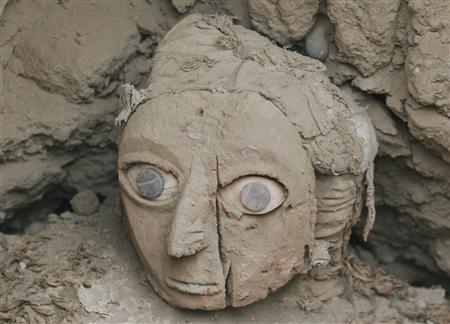A few years ago, archaeologists working at Peru’s Huaca Pucllana ruins made a remarkable discovery: a mummy from the ancient Wari Culture (450-1000 AD), which thrived before the Inca civilization. The tomb, containing the remains of two other adults and a child, was the first intact Wari burial site uncovered at Huaca Pucllana in Lima, and researchers believe it dates back to around 700 AD.
The female mummy, known as “La Dama de La Mascara” (Mask Lady), is particularly astonishing due to her striking mask featuring bright, blue eyes. These blue eyes, made of seashells, add an air of mystery as their exact significance remains unclear. This discovery provides valuable insights into the Wari Culture and their burial practices, offering a rare glimpse into the life and customs of this ancient pre-Inca civilization.

Huaca Pucllana, an archaeological site in Lima, Peru, contains the ruins of an ancient plaza and a partially excavated mound of rocks, bricks, and dirt. So far, about 30 tombs have been unearthed there, but yesterday’s discovery was the most exciting.
“We’d discovered other tombs before,” said Isabel Flores, the director of the ruins. “But they always had holes, or were damaged. Never had we found a whole tomb like this one—intact.”
The mummy sat in a deep hole walled in with crumbling bricks. A pair of large blue eyes glared menacingly from its wooden face mask.

“Her face startled me at first,” said Miguel Angel, 19, who was working with the archaeologists at the dig. “I wasn’t expecting to find anything like that.”
The workers carefully covered the mummy in tissue paper before lifting it onto a wooden board.
Next to the mummy was an array of tools and other objects, including ceramics and textiles.
The Wari had a capital near the modern city of Ayacucho in the Andes, but they developed an extensive road network and traveled across the whole region.
The Incas did not start to conquer and dominate Peru until the 13th century AD.
